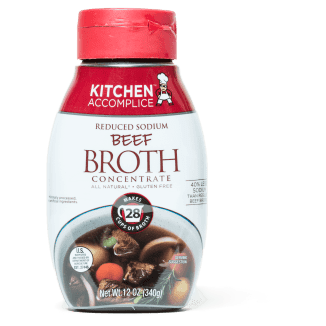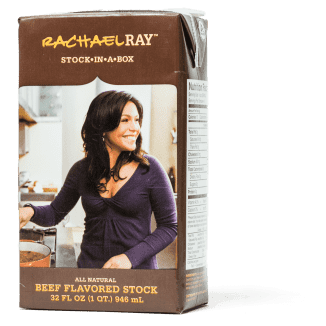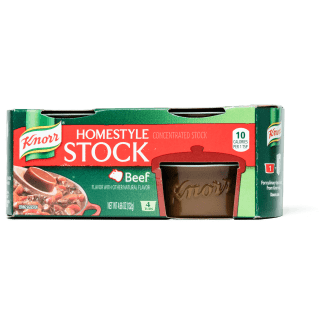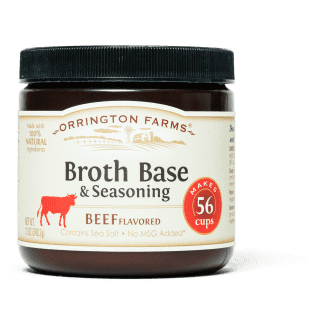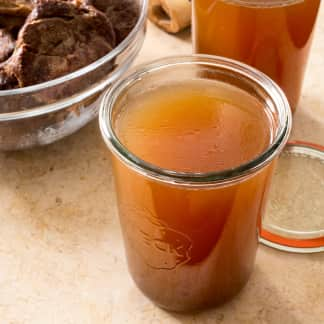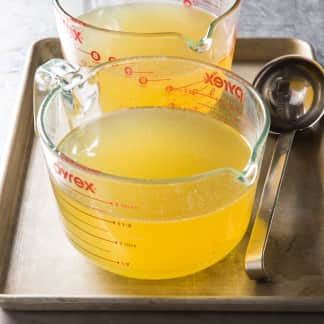It’s hard to beat the convenience of store-bought broth. Truth be told, we turn to it often when making soups, stews, and gravies. Our winning commercial chicken broth is a pretty good stand-in for the real thing, but we’ve had less luck finding a decent beef broth. Part of the reason is that we expect more of beef broth. We typically rely on chicken broth to bolster the savory backbone of a recipe. But when we turn to beef broth, we want it to literally beef up the flavor of a dish.
A slew of new products have hit the beef broth market since our last tasting and not just the mainly liquid contenders we’ve seen in the past. Hopeful that a better, truly beefy broth had come along, we rounded up 10 options from top-selling brands—including liquids as well as pastes, powders, and cubes that must be reconstituted with hot water—that contained at least 450 milligrams of sodium per serving (in previous broth tastings, we’ve found that products with less sodium taste underseasoned). We sampled these broths simply warmed, simmered in a beef and vegetable stew, and reduced in gravy.
Unfortunately, we were once again largely unimpressed with all the products we tasted. None delivered anything close to true beef flavor. At best, the broths contributed a savory taste, while the worst were either bland, overwhelmingly salty, or plagued by “bitter,” “charred,” or “burnt” off-notes. In the end, we had just one product to recommend. Though lacking in actual beefy taste, it delivered “fuller” flavor than any of the other products.
There’s an obvious explanation for the absence of beefy flavor in commercial broth products: They lack beef.
Where’s the Beef?
There’s an obvious explanation for the absence of beefy flavor in commercial broth products: They lack beef. To meet U.S. Department of Agriculture standards, liquid products labeled “beef stock” or “beef broth” (the government doesn’t distinguish between the two) need only contain 135 parts moisture to 1 part protein (which may be derived from meat or bones). The regulations that guide the pastes, powders, and cubes in our lineup are similarly paltry or don’t exist at all. A look at the nutrition labels confirms how little meat goes into them: Five of the 10 products have 1 gram or less of protein per cup, including our new winner. Meanwhile, our homemade beef broth, made with 6 pounds of meat and 2 pounds of bones per 2 quarts of water, has more than 4 grams of protein per cup.
Ultimately, however, the amount of protein in a broth had little to do with its ranking. In fact, though the liquid broths had more protein than products requiring reconstitution, in general they performed less well, exhibiting blandness or off-notes.
We learned one reason for their lackluster flavor: Most liquid broths (as well as some products requiring reconstitution) start with the same source—weak generic stock supplied by a handful of specialty stock producers. Stephanie Lynch, vice president of technology and sales at International Dehydrated Foods, one of the companies that create these stock bases, told us that they simmer water and bones—not actual meat—in large pressurized vats to create a broth base with deliberately mild flavor that can provide a blank slate for a variety of uses. The broth is dehydrated for cheaper shipping and sold to broth manufacturers, who can build on it with other flavors.



Flavor Makers
The problem is, in lieu of adding actual meat to their products, broth manufacturers mainly use chemistry to amp up flavor. According to Michael Noble, corporate chef at Ariake USA (a large commercial stock producer based in Virginia), it’s common for major broth manufacturers to hire flavor chemists to help them choose from a vast assortment of highly concentrated flavorings that can contribute a range of very specific tastes to a product. When such flavorings are distilled or extracted from natural sources, they appear as “natural flavorings” or “natural flavor” on an ingredient list; synthetically produced flavorings must be identified as “artificial.” These flavorings can help make a product taste distinct from others and yield consistent results from batch to batch. But their use can also backfire. In the products we tasted from Swanson and Imagine, for example, tasters picked up on “charred” and “burnt” notes. Though neither company would elaborate on the source of the flavors in their products, it seems likely that the off-notes we noticed came from concentrated “natural flavorings” intended to mimic the flavor of cooked beef.
Taking It Up a Notch
For broths with genuinely beefy flavor, try making our recipe for Rich Beef Broth or Quick Beef Broth, which adds real beef to our winning commercial broth.
The broth with the highest protein content by far at 7 grams per cup—College Inn—failed for an entirely different reason. Tasters detected bitter, metallic notes that almost certainly came from the inclusion of potassium chloride, the main ingredient in many salt substitutes. (With 750 grams of sodium per serving, it already had one of the highest sodium levels in the lineup.)
No matter what the form—liquid or dehydrated—what really benefited these products was the presence of yeast extract, a substance that’s loaded with glutamates and nucleotides. Glutamates are savory on their own, and nucleotides work in synergy with them to amplify their flavor. Together these compounds can boost a broth’s savory, meaty-tasting flavors twentyfold. All 10 broths include yeast extract, but our winner (and the second-place broth) also contains hydrolyzed soy protein, another powerful source of flavor potentiators that might have given it an edge over the others. Our new winner, Better Than Bouillon Roasted Beef Base, trumped our previous favorite from Rachael Ray, which simply wasn’t beefy enough to compete with our winner’s ultrasavory punch.
We’re still hopeful that someday broth manufacturers will put more actual beef in their products. In the meantime, our winner is an economical choice that stores easily, costs just 16 cents per cup, and does a good job of boosting savory depth in soups and stews.
- Warm Plain Broth
- Reduce in Gravy
- Simmer in Beef Stew
- Boosts Savory Depth
- Economical
- Stores Easily



